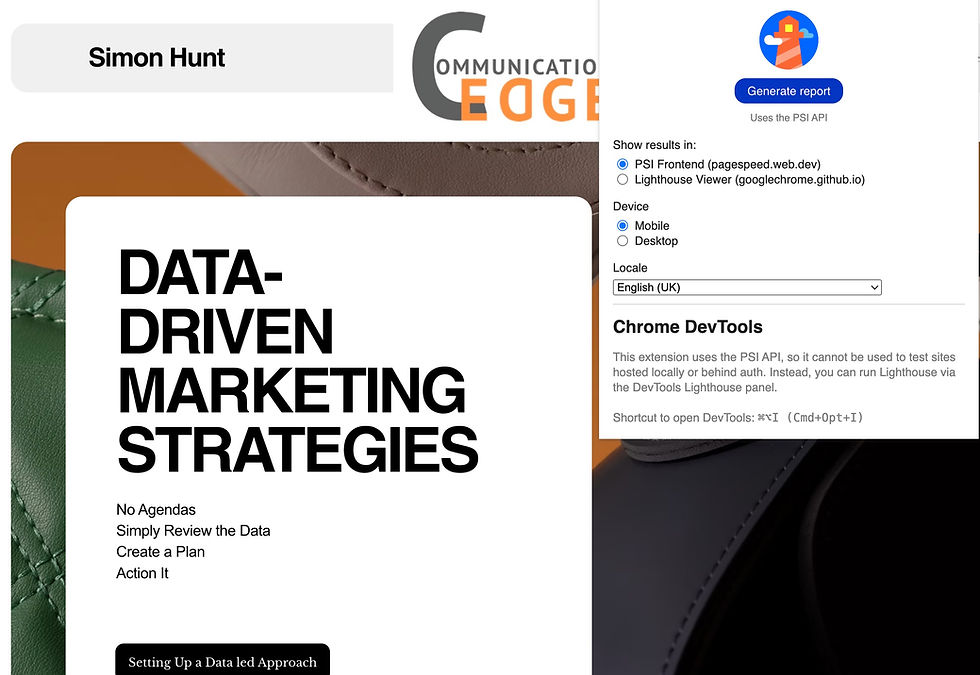Data-Driven Strategies to Master Digital Marketing Measurement and ROI
- Simon Hunt
- Jul 22
- 6 min read
Updated: Oct 24
In today's fast-paced digital world, understanding how to measure your marketing efforts is crucial. With the right data-driven strategies, businesses can not only track their performance but also make informed decisions that lead to growth.
This blog post will guide you through the essentials of digital marketing measurement. We will explore various strategies, tools, and techniques that can help you harness the power of data. By the end, you will have a clearer understanding of how to effectively measure your digital marketing campaigns.
The Importance of Measurement in Digital Marketing
Measurement is the backbone of any successful marketing strategy. Without it, you are essentially flying blind. Here are a few reasons why measurement is vital:
Informed Decision-Making: Data allows you to make decisions based on facts rather than assumptions.
Performance Tracking: You can see what is working and what is not, enabling you to adjust your strategies accordingly.
ROI Calculation: Understanding your return on investment helps you allocate resources more effectively.
Customer Insights: Data provides insights into customer behavior, preferences, and trends.
By focusing on measurement, you can optimize your marketing efforts and achieve better results.
Key Metrics to Track
When it comes to digital marketing, there are several key metrics you should track. Here are some of the most important ones:
1. Website Traffic
Website traffic is a fundamental metric that indicates how many visitors are coming to your site. You can track this using tools like Google Analytics.
Unique Visitors: This shows how many individual users visit your site.
Page Views: This indicates how many pages are viewed during a session.
2. Conversion Rate
The conversion rate measures the percentage of visitors who take a desired action, such as making a purchase or signing up for a newsletter.
To calculate it, use the formula:
```
Conversion Rate = (Number of Conversions / Total Visitors) x 100
```
3. Bounce Rate
The bounce rate indicates the percentage of visitors who leave your site after viewing only one page. A high bounce rate may suggest that your content is not engaging enough.
4. Customer Acquisition Cost (CAC)
CAC measures how much it costs to acquire a new customer. This metric is crucial for understanding the efficiency of your marketing efforts.
To calculate CAC, use the formula:
```
CAC = Total Marketing Expenses / Number of New Customers
```
5. Return on Investment (ROI)
ROI is a critical metric that helps you understand the profitability of your marketing campaigns.
To calculate ROI, use the formula:
```
ROI = (Net Profit / Cost of Investment) x 100
```
By tracking these metrics, you can gain valuable insights into your marketing performance.
Tools for Measurement
There are numerous tools available to help you measure your digital marketing efforts. Here are some popular options:
Google Analytics
Google Analytics is a powerful tool that provides in-depth insights into your website traffic. You can track user behavior, conversion rates, and much more.
SEMrush
SEMrush is an all-in-one marketing tool that helps you analyze your SEO, PPC, and content marketing efforts. It provides valuable data on keyword performance and competitor analysis.
HubSpot
HubSpot offers a suite of marketing tools that include analytics, email marketing, and social media management. It is particularly useful for tracking leads and conversions.
Hootsuite
Hootsuite is a social media management tool that allows you to track engagement metrics across various platforms. You can measure likes, shares, and comments to gauge your social media performance.
Mailchimp
Mailchimp is an email marketing platform that provides analytics on open rates, click-through rates, and subscriber engagement. This data is essential for optimizing your email campaigns.
By leveraging these tools, you can gather the data you need to make informed decisions.
Data-Driven Strategies for Improvement
Once you have collected your data, the next step is to use it to improve your marketing efforts. Here are some data-driven strategies to consider:
A/B Testing
A/B testing involves comparing two versions of a webpage or marketing material to see which performs better.
For example, you might test two different email subject lines to see which one results in a higher open rate.
Personalization
Using data to personalize your marketing messages can significantly improve engagement.
For instance, if you know a customer’s previous purchases, you can send them targeted recommendations that are more likely to resonate.
Segmentation
Segmenting your audience based on demographics, behavior, or preferences allows you to tailor your marketing efforts.
For example, you might create different email campaigns for new customers versus returning customers.
Retargeting
Retargeting involves showing ads to users who have previously visited your site. This strategy can help bring back potential customers who did not convert the first time.
Continuous Monitoring
Data-driven marketing is not a one-time effort. Continuously monitor your metrics and adjust your strategies as needed.
Regularly reviewing your data will help you stay ahead of trends and make timely adjustments.
Case Study: A Real-World Example
To illustrate the power of data-driven strategies, let’s look at a case study of a fictional online retail store, "Trendy Threads."
Background
Trendy Threads specializes in selling fashionable clothing online. They wanted to improve their conversion rates and overall marketing performance.
Strategy Implementation
Data Collection: They started by using Google Analytics to track website traffic and user behavior.
A/B Testing: Trendy Threads conducted A/B tests on their product pages, testing different layouts and calls to action.
Email Personalization: They used customer data to send personalized email recommendations based on previous purchases.
Retargeting Campaigns: They implemented retargeting ads to reach users who had abandoned their shopping carts.
Results
After six months of implementing these strategies, Trendy Threads saw a 25% increase in conversion rates and a 15% decrease in bounce rates.
Their email open rates improved by 30%, and retargeting ads brought back a significant number of customers who had previously left the site without making a purchase.
This case study highlights how data-driven strategies can lead to tangible improvements in marketing performance.
The Future of Digital Marketing Measurement
As technology continues to evolve, so will the methods for measuring digital marketing success. Here are a few trends to watch:
Artificial Intelligence
AI is becoming increasingly important in data analysis. It can help marketers identify patterns and make predictions based on large datasets.
Enhanced Analytics Tools
New tools are emerging that offer more advanced analytics capabilities. These tools will provide deeper insights into customer behavior and preferences.
Privacy Regulations
With growing concerns about data privacy, marketers will need to adapt their measurement strategies to comply with regulations.
This may involve finding new ways to collect and analyze data while respecting user privacy.
Wrapping It Up
Mastering digital marketing measurement is essential for any business looking to thrive in the digital landscape. By focusing on key metrics, utilizing the right tools, and implementing data-driven strategies, you can optimize your marketing efforts and achieve better results.
Remember, measurement is not just about tracking numbers. It is about understanding your audience, making informed decisions, and continuously improving your strategies.
With the right approach, you can turn data into a powerful asset that drives your business forward.

FAQs: Mastering Digital Marketing Measurement with Data-Driven Strategies
What does “data-driven marketing” really mean?
It means using real-time data and analytics to make informed marketing decisions — ensuring every campaign is measurable, optimised, and aligned to business goals.
Why is marketing measurement important for small and mid-sized businesses?Measurement turns marketing from a cost into an investment by showing exactly how each pound spent contributes to leads, conversions, and growth.
What are the key metrics businesses should track to measure marketing performance?
Core metrics include website traffic, conversion rate, Cost per Lead (CPL), Customer Acquisition Cost (CAC), and Return on Marketing Investment (ROMI).
How do data-driven strategies improve marketing ROI?
They identify which channels perform best, remove wasted spend, and focus investment on the tactics that deliver measurable results.
What tools are essential for measuring digital marketing effectively?
GA4, HubSpot, and Looker Studio are key for tracking performance, visualising KPIs, and integrating data from multiple sources into one view.
How can a marketing dashboard help improve decision-making?
Dashboards provide real-time visibility into performance data — helping teams act faster, adjust budgets, and demonstrate ROI to stakeholders.
What’s the difference between vanity metrics and actionable metrics?
Vanity metrics (like impressions or followers) look good but don’t show value. Actionable metrics (like leads or revenue) connect directly to commercial outcomes.
How often should businesses review their marketing data and KPIs?
Weekly monitoring ensures agility, while monthly board reports summarise performance trends and key learnings for continuous optimisation.
How can SMEs build a culture of data-driven marketing?
By setting clear KPIs, implementing transparent reporting systems, and holding teams accountable for measurable performance improvements
.
How can Communications Edge help businesses master data-driven marketing measurement?
Communications Edge builds integrated analytics frameworks, Looker Studio dashboards, and marketing measurement systems that deliver board-ready insights and proven ROI.





Comments